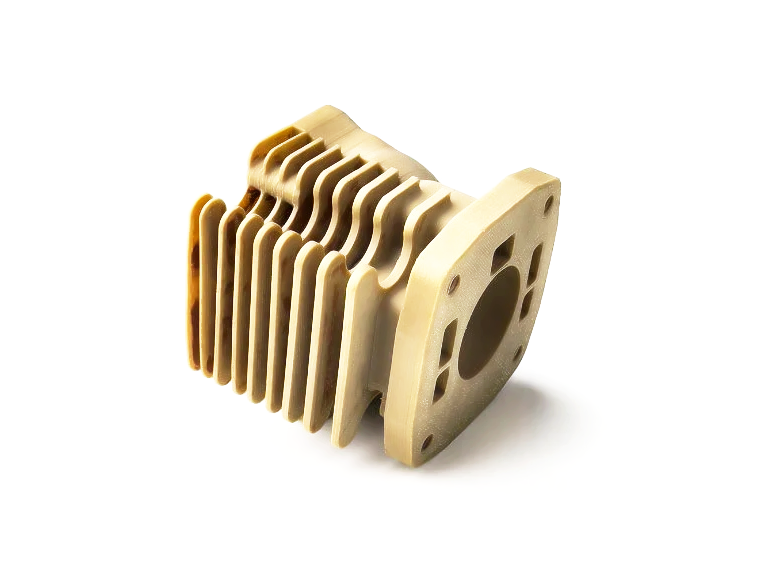Enhancing Efficiency With Custom Plastic Insulation Components Improving Energy Systems
Introduction
Plastic 3D printing is advancing energy systems by enabling the production of custom, high-performance insulation components that enhance thermal management and electrical isolation. Using advanced plastic 3D printing technologies such as Fused Deposition Modeling (FDM), Stereolithography (SLA), and Multi Jet Fusion (MJF), advanced plastic materials like Nylon (PA), PETG, and PEEK deliver excellent thermal, electrical, and mechanical properties for energy applications.
Unlike traditional insulation manufacturing, plastic 3D printing for energy systems enables rapid prototyping, complex geometry integration, lightweight designs, and cost-effective small-batch production.
Applicable Material Matrix
Material | Dielectric Strength (kV/mm) | Thermal Resistance (°C) | Mechanical Strength | Surface Finish Quality | Energy Systems Suitability |
|---|---|---|---|---|---|
20–30 | ~120 | High | Very Good | Cable holders, insulating frames | |
15–20 | ~80 | Moderate | Excellent | Protective covers, separator panels | |
25–30 | ~250–300 | Very High | Good | High-temperature insulation supports | |
10–15 | ~60 | Moderate | Good | Prototyping insulation parts | |
12–16 | ~95 | High | Good | Electrical enclosures and insulators | |
15–18 | ~130 | Very High | Excellent | Impact-resistant insulating housings |
Material Selection Guide
Nylon (PA): With excellent mechanical strength, thermal stability (~120°C), and good dielectric properties, Nylon is ideal for insulating brackets, supports, and cable management systems in power and energy devices.
PETG: Combining moderate dielectric strength and toughness, PETG is suited for transparent protective covers, partition panels, and non-structural insulation components.
PEEK: Offering outstanding thermal resistance up to 300°C and exceptional dielectric strength (~30 kV/mm), PEEK is used in high-temperature insulation supports for high-voltage and high-load energy systems.
PLA: Easy to print and cost-effective, PLA is used for early-stage insulation and housing components prototypes where thermal and electrical demands are moderate.
ABS: Good impact resistance and acceptable dielectric properties make ABS appropriate for enclosures, fixture plates, and protective casings for electrical equipment.
Polycarbonate (PC): High toughness, thermal endurance, and moderate dielectric strength make PC suitable for impact-resistant insulating housings and safety covers in energy applications.
Process Performance Matrix
Attribute | Plastic 3D Printing Performance |
|---|---|
Dimensional Accuracy | ±0.1 mm |
Surface Roughness (As-Printed) | Ra 5–15 μm |
Layer Thickness | 50–200 μm |
Minimum Wall Thickness | 0.8–1.5 mm |
Feature Size Resolution | 300–600 μm |
Process Selection Guide
Complex Insulation Geometries: 3D printing supports the fabrication of custom insulation barriers, covers, and supports with embedded features for easy assembly and enhanced thermal/electrical isolation.
Lightweighting: Advanced plastics enable the production of lightweight components critical for portable energy devices and systems requiring strict weight constraints.
High-Temperature Resistance: Materials like PEEK and PC ensure component performance even in high-load or high-temperature energy applications.
Rapid Development and Small-Batch Production: 3D printing facilitates fast iteration cycles for new energy systems and on-demand production of specialized insulating parts.
Case In-Depth Analysis: PEEK 3D Printed High-Voltage Insulation Supports for Renewable Energy Storage
An energy storage system integrator required high-performance, lightweight insulating supports for a battery array exposed to elevated temperatures and high voltages. Using our plastic 3D printing service with PEEK, we produced insulation supports achieving thermal resistance above 250°C, dielectric strength >25 kV/mm, and precision tolerances within ±0.1 mm. The conformal, lightweight design optimized space utilization inside the battery enclosure and improved operational safety. Post-processing included fine CNC machining and surface treatment for critical mounting interfaces.
Industry Applications
Energy Storage and Power Systems
Battery pack insulation plates and module separators.
High-voltage supports and cable routing systems.
Renewable Energy Systems
Solar inverter and converter insulation parts.
Wind turbine internal insulation covers.
Industrial Automation and Electrical Equipment
Insulating housings for industrial control cabinets.
Custom terminal blocks and wiring organizers.
Mainstream 3D Printing Technology Types for Plastic Insulation Components
Fused Deposition Modeling (FDM): Ideal for robust, functional insulating components using engineering plastics like Nylon and PETG.
Stereolithography (SLA): Best for fine-detailed insulating components requiring smooth surfaces.
Multi Jet Fusion (MJF): Suitable for high-volume, consistent production of plastic insulating parts with good mechanical properties.
FAQs
What plastic materials are best for 3D printed insulation components in energy systems?
How does plastic 3D printing improve energy storage, power system efficiency, and safety?
What are the post-processing options for enhancing the performance of plastic insulating parts?
Can plastic 3D printed insulation components handle high-voltage, high-temperature environments?
How does 3D printing accelerate prototyping and production of custom insulation components for energy applications?

